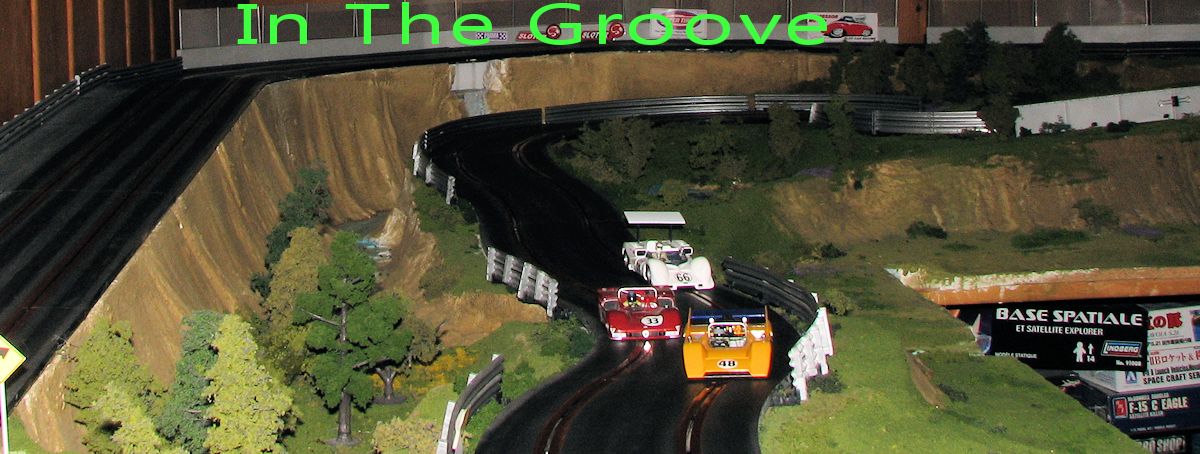

It has been well over a year since I last provided any information to you about how the slot cars are coming along and I thought it may well be time to provide an update of sorts. Actually, it may have been two.
The track itself has not been touched for quite some time, I added a grove or two of trees back in 2010 or so, but that is pretty well it. You can see these in the header image on the left side and in the top right. I still use the track pretty much daily for around a half hour or more. It is a great way to spend some time having fun and keep the reflexes going. While I continue to get newer releases as the interest takes me, that has slowed down quite a bit and I've actually been selling off extras and cars that no longer strike my fancy. I can do that without dealing with Internet sales by vending at a local slot car show that happens twice a year.
Meanwhile, I have been upgrading some ill-handling cars
with new tires and wheels. It is a sad fact that when one buys what is basically
a mass produced toy, it is inevitable that the quality control will not be to
the standards that one wishes. The biggest issue with most 'made in China' cars
(and most of them
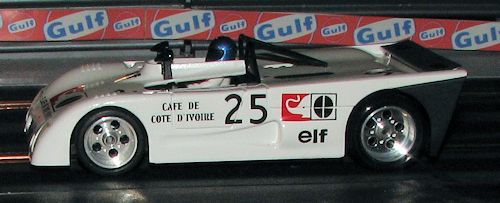 are), is
that the wheels are not round. Replacing them with stock wheels often results in
another out of round wheel so the only way to prevent this from being an issue
is to purchase aftermarket aluminum, or in some cases, magnesium wheels. A
variety of vendors produce these items with some producing blank wheels that
require inserts and others their own design of aluminum wheel. You can see two
styles that I like on the #25 Lola and the #14 Porsche.
are), is
that the wheels are not round. Replacing them with stock wheels often results in
another out of round wheel so the only way to prevent this from being an issue
is to purchase aftermarket aluminum, or in some cases, magnesium wheels. A
variety of vendors produce these items with some producing blank wheels that
require inserts and others their own design of aluminum wheel. You can see two
styles that I like on the #25 Lola and the #14 Porsche.
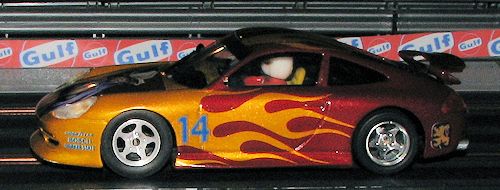 When
going this route, one often runs into another issue. Not all manufacturers use a
standard size axle. Nearly all aftermarket wheels for plastic cars are based on
a 3/32 (2.78mm) axle, but if the company uses one that is 3mm or even a bit
larger, then you can see that they are not compatible. An axle that is loose in
the bearing will have excess movement and while that is not much of an issue for
a front axle, it is for the rear where gear mesh needs to be constant. The
result is often that changing wheels requires changing axles and bearing and the
rear gear. This can get pricey if using quality materials and with the new tires
required for the new wheels can generally run to about $40 or more per car.
However, the results in a smoother running car that doesn't bounce up and down
due to the out of round wheels and has a smooth gear mesh is well worth it for
most of us. This additional smoothness also results in quicker lap times.
When
going this route, one often runs into another issue. Not all manufacturers use a
standard size axle. Nearly all aftermarket wheels for plastic cars are based on
a 3/32 (2.78mm) axle, but if the company uses one that is 3mm or even a bit
larger, then you can see that they are not compatible. An axle that is loose in
the bearing will have excess movement and while that is not much of an issue for
a front axle, it is for the rear where gear mesh needs to be constant. The
result is often that changing wheels requires changing axles and bearing and the
rear gear. This can get pricey if using quality materials and with the new tires
required for the new wheels can generally run to about $40 or more per car.
However, the results in a smoother running car that doesn't bounce up and down
due to the out of round wheels and has a smooth gear mesh is well worth it for
most of us. This additional smoothness also results in quicker lap times.
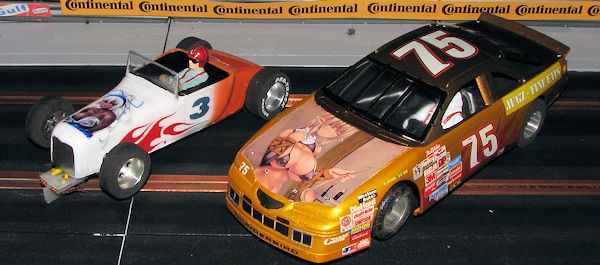 As some
of you know, I also race with the local slot car club. This club races on three
different types of track. First is a wood oval track. This is a yearly series
that will see us run about a dozen races. It changes each year, but as is often
the case with brass chassis cars, the chassis gets reused with little more than
a new body. For 2014 it is vintage dirt cars (we ran this chassis two years ago
as Indy roadsters) and hardbody NASCAR (this runs on an H&R chassis that is used
for a wide number of cars. This last season it was used for winged sprint cars).
As some
of you know, I also race with the local slot car club. This club races on three
different types of track. First is a wood oval track. This is a yearly series
that will see us run about a dozen races. It changes each year, but as is often
the case with brass chassis cars, the chassis gets reused with little more than
a new body. For 2014 it is vintage dirt cars (we ran this chassis two years ago
as Indy roadsters) and hardbody NASCAR (this runs on an H&R chassis that is used
for a wide number of cars. This last season it was used for winged sprint cars).
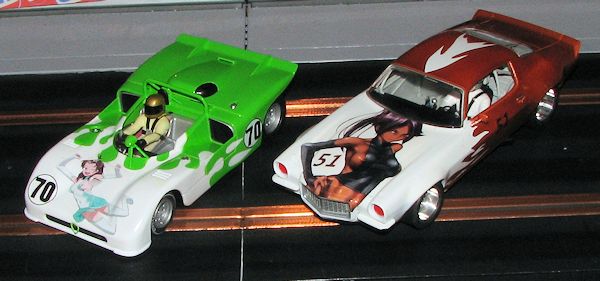 Another
year long series is for plastic track. On this track we race cars that have
traction magnets (mainly because of of the series' tracks is quite rough and
need the magnet to hold the car in place. Racing with magnets takes a whole
different set of skills from running on wood tracks as the key here is to
maintain the magnetic attraction with the power rails, so sliding isn't the
fastest way around. For this season, the choices were Slot.it sidewinders and
Classic Trans-Am. For the first class, the cars have to be pretty much as they
are with only tire changes allowed. On plastic, silicone tires usually run the
best. For the Trans-Am series, we can change wheels, tires, gearing and guide.
All cars run with a spec motor. The ideal behind all of these classes is to keep
the cars equal so that it is driver skill and luck that determines how well one
does.
Another
year long series is for plastic track. On this track we race cars that have
traction magnets (mainly because of of the series' tracks is quite rough and
need the magnet to hold the car in place. Racing with magnets takes a whole
different set of skills from running on wood tracks as the key here is to
maintain the magnetic attraction with the power rails, so sliding isn't the
fastest way around. For this season, the choices were Slot.it sidewinders and
Classic Trans-Am. For the first class, the cars have to be pretty much as they
are with only tire changes allowed. On plastic, silicone tires usually run the
best. For the Trans-Am series, we can change wheels, tires, gearing and guide.
All cars run with a spec motor. The ideal behind all of these classes is to keep
the cars equal so that it is driver skill and luck that determines how well one
does.
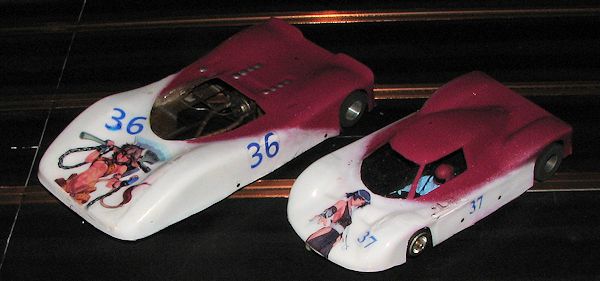 The third
series is wood road courses. There are many more of these sorts of tracks than
wood ovals or plastic tracks so we run a half year series, but they are run more
often. I do not attend all of these events as many of the tracks are farther
away than I like to drive. You see, most of the tracks are a minimum of about 50
miles away and those I do not attend are quite a bit farther. For this season,
it is Daytona Prototypes and Can Am cars, all on brass chassis. While I have two
cars ready to go, I'll be putting on new bodies. The ones I painted have issues
with the paint sticking to them. I used an acrylic designed for the clear lexan
bodies, but it comes off so easily that I just don't like it. But here are the
two I painted up for this season. I am currently doing two new bodies to replace
these.
The third
series is wood road courses. There are many more of these sorts of tracks than
wood ovals or plastic tracks so we run a half year series, but they are run more
often. I do not attend all of these events as many of the tracks are farther
away than I like to drive. You see, most of the tracks are a minimum of about 50
miles away and those I do not attend are quite a bit farther. For this season,
it is Daytona Prototypes and Can Am cars, all on brass chassis. While I have two
cars ready to go, I'll be putting on new bodies. The ones I painted have issues
with the paint sticking to them. I used an acrylic designed for the clear lexan
bodies, but it comes off so easily that I just don't like it. But here are the
two I painted up for this season. I am currently doing two new bodies to replace
these.
You can probably tell that I like to paint slot car bodies, and over the last few years have done quite a few of them. Since I make my own nose art for them, they are generally white on the front where the artwork goes. This is because printing your own decals limits you to using a white surface. I have also put the nose art of white decal paper rather than clear if the background is dark. Print your own decals tend to be quite transparent when doing the lighter colors.
For the home track, I have done a number of cars. I like the Porsche 911/997 because they have a large hood that is devoid of vents and intakes. Having to cut a decal to fit around these things is a bit of a pain. I visit slot car boards and ask for 'junker' cars or ones people no longer want. I then strip the paint or sand it off, clean up seams, add in whatever bits are missing and so on. Generally I get pretty complete cars that have just been run a lot and often have cracks or chips in the body bits. Folks will sell them for a lot less than new ones and since I'm going to repaint them I don't care if the paint is scuffed up or scraped, wheels are missing, and so on.
So here are some of the cars from the last year or two.
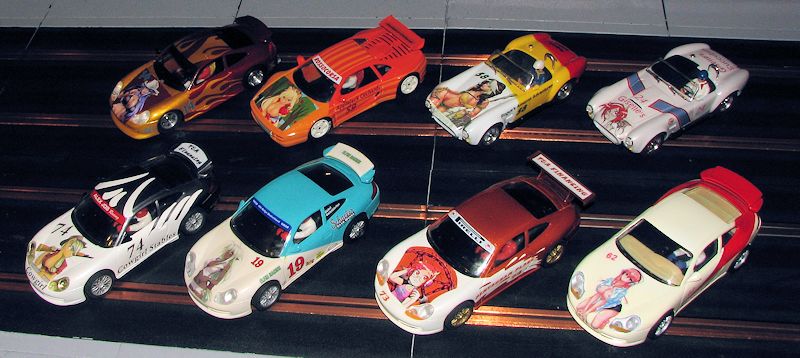
The brand names will probably mean nothing to you, but I'll list them anyway. On this one, starting at the top left are two Pro-Slot cars; a Porsche and a Ferrari. On these two, the nose art was printed on white decal paper along with a background. In some cases, I'll even have to put on two decals to get enough density. For this reason alone, I usually print up three nose art markings each time so I have a spare. Next are two Ninco Cobras. The hood scoop on these made the first car a difficult application. Add in the curves of the fenders and you can see this is not my favorite car to repaint. All four of the Porsche 997s are from Ninco. I like these as they are easy to disassemble, but not easy to remove the paint from. I generally end up sanding the paint away.
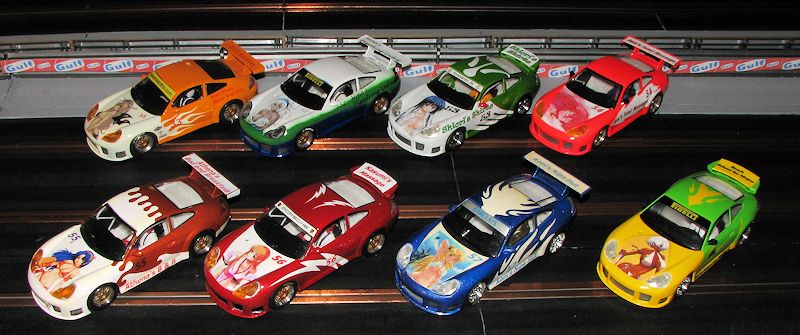
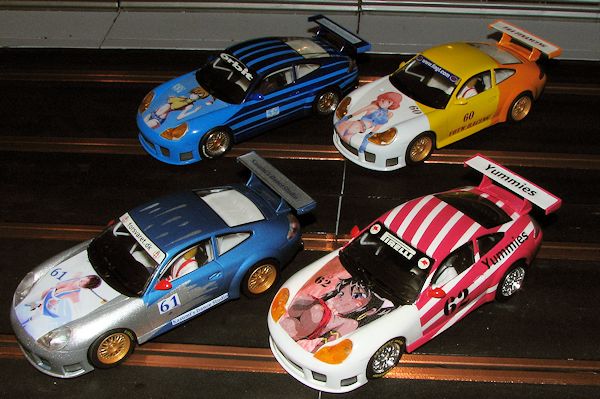
The next two photos are all Scalextric Porsches. Scalextric is probably the most widely known and sold brand of slot car that there is. Their cars are all fairly well built, somewhat inexpensive, and will run well right out of the box. You would think that they would all run right out of the box, but that is not the case. Some require quite a lot of work just to get them to run properly. If you are wondering why anyone would buy a product that doesn't work as advertised from the start then the answer is because we want that particular car and are willing to put in the additional effort. It is like buying a short run or resin model kit. You do the additional work because you want the product.
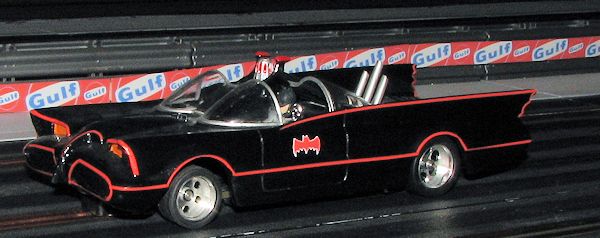
And finally, from time to time I like to take a model kit and convert it to a slot car. For this last year or so I have done two. One has been the Polar Lights Batmobile. This one was a bit of a challenge as I wanted to keep the interior as complete as I could. I also had difficulty finding a chassis that was long enough, but was able to do a modification to one to meet that need.
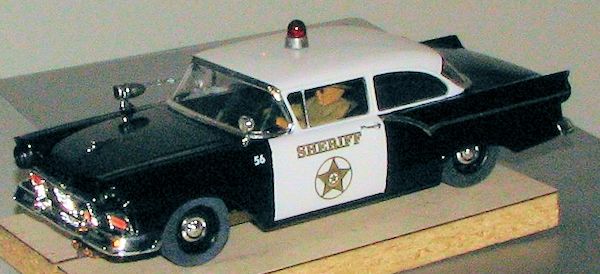
The other I did was for a rather unique event that is held once a year called Thunder Road after the movie. One can either build a police car or a moonshiner's car. This year I had the only police car in the group. Did not win, but had a lot of fun and took best of show.
I hope you learned a bit and if you have any questions or wish to share your experiences or images of your track, I'd like to hear from you on the subject so please e-mail me at svanaken61@gmail.com Please note that the previous e-mail has become quite unreliable and is no longer used.
Scott
December 2013